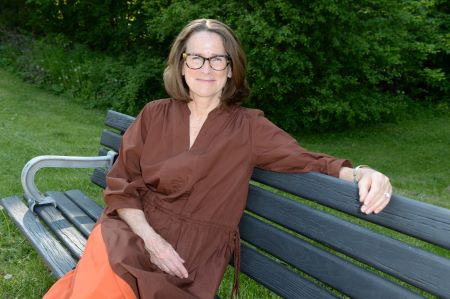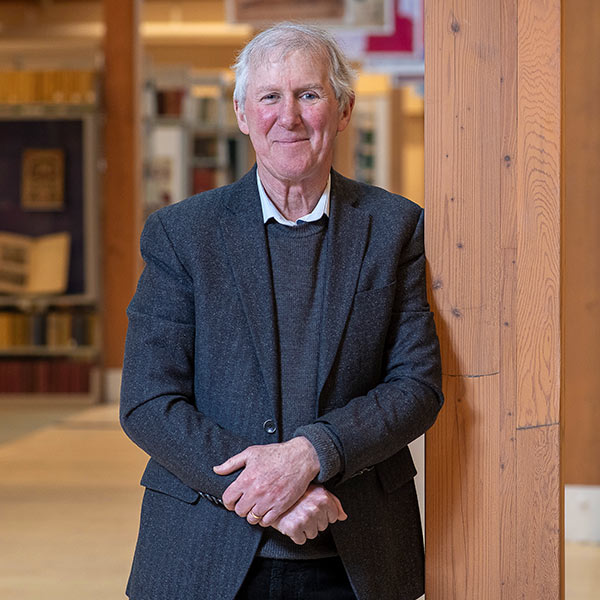You wouldn’t expect the head of Canada’s home to the Group of Seven to describe the traditional art collection as “very pale and male” but when it comes to expanding the historic boundaries of Canadian art, Sarah Milroy can definitely see the forest for the post-impressionist trees.
Last fall, Milroy, BA’79, became the new executive director (in addition to her existing job as chief curator) of the McMichael Canadian Art Collection, located north of Toronto. The museum, of course, is tightly connected to the Group of Seven and their works – so much so that six members of the group are buried nearby in the McMichael Cemetery. Still, Milroy is determined to tell the story of art in Canada with diverse voices and visions of artists – beyond the core canon of the country’s famous landscape painters from the 1920s.
“We’re not just making a museum about art, we’re making a museum about Canada and there’s much more to Canada than the Group of Seven,” she says.
A native of British Columbia, Milroy chose McGill for her university studies. While studying English literature “with a heavy dose of sociology and history”, Milroy recalls McGill professors including English professor Irwin Gopnik and sociology professor Richard Hamilton. As a student living in an apartment on Carré Saint-Louis, she was a devoted fan of the small cafés on Prince Arthur Street, and the omnipresent music of 70s prog rock band Harmonium. Three years at Cambridge University followed, as she pursued her graduate studies in English.
Her lifelong interest in art (her mother, Elizabeth Nichol, was a Vancouver gallery owner) led Milroy to the Nova Scotia College of Art and Design in Halifax. It was there that she developed her interest in contemporary art and wrote her first review of an exhibition by Canadian painter Paraskeva Clark, a contemporary of the Group of Seven.
“This was political art. It was a revelation to me because I thought that Canadian historical art was only about landscape.”
Sarah Milroy
“Clark was a Russian immigrant artist whose social realist works depicted cities and people. This was political art,” says Milroy. “It was a revelation to me because I thought that Canadian historical art was only about landscape.”

Milroy served as editor and publisher of Canadian Art magazine before taking on the job of Globe and Mail art critic from 2001 to 2011. Among the hundreds of articles with her byline was a particularly poignant piece about Brooklyn-based Canadian artist Susanna Heller, written just after the 9/11 attacks.
“After the twin towers came down, Susanna would walk across the Williamsburg Bridge every day to Ground Zero and paint the ruins of the towers,” says Milroy. “I walked around the site with her one morning as she shared her thoughts and feelings about this pivotal point in history and her response to it. It was very emotional, harrowing really, and I felt I was able to capture that experience for readers.”
After leaving the Globe and Mail, Milroy was pondering her next career move when she began receiving invitations to curate exhibitions. That, in turn, led to her breakout moment as co-curator of a wildly-successful touring exhibition From the Forest to the Sea: Emily Carr in British Columbia, 2014, an event which wowed audiences at the Dulwich Picture Gallery in London, England – including Prince Charles (now King Charles III) – before its Canadian presentation at the Art Gallery of Ontario.
Four years later, Milroy took on the most challenging role of her career as chief curator of the McMichael Canadian Art Collection, a museum she once described as “tartan-and-shortbread, known for its quaint Canadiana atmosphere, out in the woods.”
“My friends who know that I love contemporary art were a little mystified because the institution still had the reputation of being very conservative,” says Milroy. “But there was so much to work with. For example, the gallery has a long history of acquiring and presenting Indigenous art. Why is that history not better known? It struck me as a spectacular opportunity to interrogate the legacies of the Group of Seven by challenging them with the work of other artists – both Indigenous and from diasporic communities – and by contemporary art generally.”
Since Milroy arrived, the gallery has funded and acquired close to a million dollars’ worth of contemporary Indigenous art, and a growing number of key works by other leading artists of colour. As well, she has sought to deepen the gallery’s representation of art by women, both in the collection and in the exhibition program, a cohort that has been historically under-represented, underfunded and unincluded in the history of Canadian art, particularly at the McMichael.
That oversight inspired Milroy’s Uninvited: Canadian Women Artists in the Modern Moment, a major exhibition of more than 200 works that coincided with, and offered commentary on, the centenary celebration of the Group of Seven. By the time the tour ended, the exhibition had been seen by more than 250,000 people across Canada.
In fact, touring exhibitions have become a mainstay of the McMichael over the past five years, expanding the museum’s reach far beyond the confines of its Kleinburg location, with eight or more exhibitions out on the road across Canada and the U.S. at any given time.
“Touring has been a huge game changer for us because it just means we can interact at a completely different level with the public, and reach Canadians from coast to coast,” says Milroy.
Meanwhile, back at Kleinburg, Milroy also has her sights set on renovating and expanding the gallery with designated facilities for weddings and conferences, and updated exhibition spaces, all of which are designed to put the McMichael on the road to a sustainable and successful future, with gallery visitors squarely at the centre of the McMichael experience. “Exhibitions tell stories, and we will continue to deliver those stories in a warm and accessible way,” says Milroy. “We’re building a solid future for this institution.”


